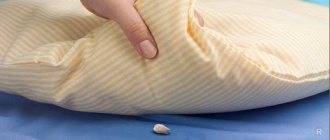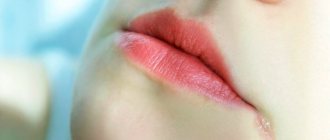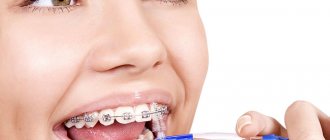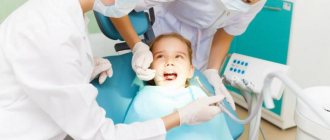Why do temporary teeth fall out?
The process of changing elements of the dentition does not happen just like that. The appearance of the first teeth occurs between the ages of 6 and 9 months, when children begin to eat not only mother's milk, but also denser foods. At the same time, the dimensions of the maxillofacial apparatus are small, and therefore the dimensions of the first teeth are quite compact. Over the years, primary teeth are no longer able to perform chewing functions properly, and the jaw enlarges. As a result, it is able to accommodate all molars.
Approximate timing and sequence of shifts
According to a large number of parents, the process of changing primary teeth begins when children lose their first tooth, which usually occurs at the age of about 6-7 years. But this is a wrong opinion, because this process begins long before this moment. After reaching the age of 4, children's third molars, which are molars, emerge. It is from this moment that the countdown begins.
Around the same time, the roots of primary teeth dissolve, which takes up to 24 months. During the resorption of root tissues, the baby tooth begins to wobble, and by the time the permanent ones appear, the corresponding element of the dentition is pushed out.
The sequence of teeth changing is approximately the same as the order in which they erupt. First, the central lower incisors fall out, after which a similar change of upper teeth occurs. Then the lateral incisors, first molars, canines and large molars are gradually replaced. The change of the first milk tooth and the loss of the last one can occur at different ages; the differences can reach 2 years. According to some experts, girls lose their baby teeth earlier than boys.
The table shows an approximate schedule for the replacement of temporary teeth with molars.
| Baby teeth | Beginning and duration of dissolution of the root of a temporary tooth | Age |
| Central lower incisors | From 6 years (within 24 months) | 6-7 years |
| Central upper incisors | From 6 years (within 24 months) | 6-7 years |
| Lateral lower incisors | After 6 years (within 24 months) | 7-8 years |
| Upper lateral incisors | After 6 years (within 24 months) | 7-8 years |
| Small (first) upper molars | From 7 years (within 36 months) | 8-10 years |
| Small (first) lower molars | From 7 years (within 36 months) | 8-10 years |
| Upper canines | From 8 years old (for 36 months) | 9-11 years |
| Lower canines | From 8 years old (for 36 months) | 9-11 years |
| Large (second) lower molars | After 7 years (within 36 months) | 11-13 years old |
| Large (second) upper molars | After 7 years (within 36 months) | 11-13 years old |
The age of teeth change is coming: what to expect and how to act?
If you think that this process begins exactly from the moment the baby’s first baby tooth falls out, then you are mistaken. In fact, the replacement occurs gradually long before this.
Somewhere around the age of four or five years, the child begins to erupt his first permanent teeth - the third molars. Many doctors call this period the starting point.
In addition, the roots of baby teeth are reabsorbed in parallel. This complex process will take about two years, because the root tissue must dissolve. Resorption occurs from the very top of the root to the base, after which the tooth will begin to wobble and soon fall out.
The first temporary tooth usually falls out at the age of six or seven years, but by the age of five you may notice that the gaps between the child’s teeth are increasing, and they themselves are slowly moving apart. You can even keep a chart of tooth loss. So his maxillofacial apparatus is gradually preparing for the change of teeth. If this does not happen, then it is better to take the baby for a consultation with an orthopedist and orthodontist.
Main features and timing of the process and order
As a rule, the change order is approximately the same as the order during the eruption of primary teeth:
- The central incisors on the lower jaw will be the first to change, and then on the upper jaw - age six to seven years;
- behind them comes the turn of the side ones in the same sequence - the age period is about seven to eight years;
- then at eight to ten years the first molars change - here the order may change, and first the permanent teeth will appear on the upper jaw, and then on the lower jaw;
- Then, from nine to eleven years, there are fangs - as a rule, their change also begins from the upper jaw;
- The last to be replaced are the second molars, first on the lower jaw, and then on the upper jaw; the age period for replacement is from eleven to thirteen years.
It would be more correct to say that the canines are replaced later than everyone else, it’s just that the temporary second molars fall out earlier, and the permanent ones will grow in after the canines. But third molars or wisdom teeth can appear at a later age - by the age of eighteen to twenty years, although in many people they do not appear at all.
Doctors focus the attention of parents on the fact that all these numbers are very individual, and the order and timing of the change, as in the case of the eruption of primary teeth, depend on many factors, including genetic predisposition / hereditary factor, and general health, and the presence certain diseases, and diet, etc.
The age difference from the time when the first tooth is replaced by a permanent one until the last baby tooth falls out in children can range from two to three years. Please note that sometimes girls can boast a full set of permanent teeth faster than boys.
Nuances you should know about
If your child’s primary teeth begin to fall out too early, do not rush to rejoice. The fact is that a significant deviation in shift timing in any direction indicates certain problems or disorders in the child’s body. For example, when a baby at the age of four no longer has many teeth, this indicates the presence of endocrine disorders.
In addition, permanent teeth may then grow incorrectly, taking on a displaced position if their temporary predecessors fall out very early and randomly.
You should not help baby teeth fall out and artificially speed up this process. Many parents try to pull out a loose tooth on their own, using all sorts of folk methods, such as tying a thread or pressing with a finger. Dentists do not advise doing this, so as not to damage the child’s gums. The tooth will easily fall out on its own when its roots are completely dissolved.
But if you see that a permanent tooth has already appeared, but the temporary one still does not fall out, then it is better to consult a doctor, because this will interfere with proper eruption. Removal is also recommended if the child experiences severe discomfort, inflammation or pain.
If a tooth falls out, a bleeding wound will remain in the socket. Since this is only capillary bleeding, it should go away within ten minutes. You can give your baby a sterile cotton or gauze swab to bite on.
It was once advised to rinse your mouth with peroxide, but this is not necessary. But if you are concerned about preventing infection, then give your child a solution of soda with iodine and let him rinse his mouth. If bleeding persists, contact your doctor to rule out problems with blood clotting.
After a tooth has fallen out, it is better not to let the child eat for two hours, and also to exclude hot, spicy and salty foods until the wound heals.
The pediatrician explains the order in which teeth change, what anomalies may occur, and how to help the child.
Nutrition during the period of changing baby teeth
The enamel of the molars is not fully formed when they erupt. This process lasts several years, so a nutritious diet with properly selected products is of great importance:
- Every day the child should eat food containing large amounts of calcium (milk and dairy products).
- In some cases, if the baby does not want to consume dairy products, it is recommended to take vitamins with a high calcium content.
- Fruits and vegetables, some of them should be consumed in solid form in order to more quickly dissolve milk roots and erupt molars.
- It is recommended to include fish dishes containing phosphorus in your diet twice a week. It is better to give children low-fat varieties, including pike perch, hake and pollock.
- Eliminate chocolate, white pastries and sweets from your diet. Sweet soda is considered the most dangerous for tooth enamel.
During the change of baby teeth, it is necessary to avoid the consumption of sticky or hard foods, including toffees, nuts and candies. Otherwise, you can damage the temporary tooth or cause it to fall out too early, which often causes problems in the growth of permanent teeth. In addition, children should not eat food that contains active dyes, which can negatively affect the color of the enamel of permanent teeth without the possibility of further changing it.
How baby teeth are replaced with permanent teeth
When baby teeth change, their roots begin to gradually dissolve, giving way to new ones.
How does this mechanism start?
- All permanent tooth buds are separated from the deciduous roots by a bone plate. When the molar tooth germ begins to develop and increase in size, it puts pressure on the bone plate.
- During this process, osteoclasts appear - cells that dissolve the mineral component of the bone.
- In parallel with the “attack” of osteoclasts from the outside, the tooth experiences internal changes: its pulp (neurovascular tissue) changes and turns into granulation tissue, which also contains osteoclasts.
- Thus, the milky roots are exposed to osteoclasts from the outside and inside and are resorbed.
- There is only one crown left: it begins to wobble and soon falls off, because it simply has nothing to hold onto the jaw.
Often this process is accompanied by an increase in body temperature and general malaise. When a tooth “comes off” from the row, slight bleeding is observed. Normally it stops after 3-5 minutes.
Care instructions
Since the enamel is not yet fully formed during the eruption of molars, great attention should be paid to proper oral hygiene and preventive measures to prevent the development of caries.
- In the morning and evening, teeth should be brushed using a soft brush that does not damage the gums. Children are recommended to use special toothpastes with a high content of calcium and fluoride. It is better to brush your teeth under adult supervision, as children often do it too quickly and not thoroughly enough.
- All children should visit the dentist twice a year for an examination, professional cleaning, and timely detection and treatment of tooth decay.
- After any meal, children should rinse their mouths with plain water, a special baby mouthwash, or chamomile infusion. Thanks to this, plaque will not accumulate on the teeth and the likelihood of developing an inflammatory process in the eruption zone of the molar will decrease.
What do you need to know about hygiene and how to care for your child’s oral cavity?
Parents often make the mistake of thinking that hygiene and caring for baby teeth is not very important, since they will fall out anyway. This is wrong, because with rotten and caries-affected temporary teeth, there will be no healthy permanent teeth.
Start caring for your baby’s oral cavity as early as the appearance of the first baby tooth, buying age-appropriate toothbrushes for him, and then, over time, toothpaste.
When permanent teeth begin to appear, you must provide your child with high-quality oral hygiene and do everything to prevent caries, because the enamel of emerging teeth is still very fragile and not fully formed.
Here's what to do:
- Be sure to supervise the morning and evening brushing of your baby’s teeth - make sure that he thoroughly and thoroughly cleans all surfaces;
- the brush should be appropriate for the child’s age and have soft bristles - this will help avoid injury to the gums;
- It’s good if the toothpaste contains the required concentration of calcium and fluoride;
- do not let your child swing loose teeth with your fingers, stop attempts to pull them out, touch a wound or a cutting tooth - explain that this can provoke the introduction and development of infection or inflammation;
- teach your baby to rinse his mouth - ideally, you should rinse after eating - you can buy a special mouthwash for children for this, or brew a chamomile decoction;
- even ordinary clean water can serve perfectly as a rinse, preventing the accumulation of plaque on the teeth and reducing the risk of developing caries or inflammation with regular rinsing of the mouth;
- Be sure to take your child for examinations to the dentist - visiting the dental office twice a year will help to detect a possible problem in a timely manner and solve it relatively painlessly and quickly.
Premature loss
This refers to the loss of baby teeth when the child has not yet reached the age of 6. Causes may include caries, special loosening and mechanical damage. If a tooth falls out long before the molar begins to grow, a space will appear in the oral cavity that will later be occupied by the remaining teeth. Eventually, permanent teeth will begin to erupt unevenly due to lack of space.
If you experience early tooth loss, you should contact an orthodontist. Often today, in such situations, prosthetic technologies are used, the main task of which is to prevent the displacement of other elements of the dentition. This solution helps prevent the development of malocclusion and the appearance of various visual defects.
Tooth loss chart
There is no need to worry if a new one has already appeared in place of the lost unit - this means that early loss is due to some hereditary factors and is not considered pathology.
- abnormal growth of a permanent tooth, although the germ is fully formed;
- congenital developmental anomaly - adentia - destruction of the rudiments of teeth in the womb;
- physiological delay of the child.
Such defects can only be detected on x-rays. Some cases require temporary, and later permanent, prosthetics.
The sequence of changing the dentition - the order of loss and eruption:
- First, the lower front incisors fall out;
- after them the upper incisors are replaced;
- then there is a change of upper and lower “twos”;
- after this comes the turn of fangs falling out;
- The last ones to fall out are the back ones - the “fours” and “fives” of the top and bottom rows.
It is difficult to determine the exact duration of the process and the timing of replacing the entire dentition. This period is different for each child and depends on the individual characteristics of the body. As a rule, baby teeth are completely replaced by permanent teeth within 4-9 years.
When a tooth is “hanging by a thread,” you should not deliberately loosen it and offer your child solid food - the process of falling out should be natural and painless
You should not offer your child food that is too hard. Do not loosen loose teeth or cauterize open sockets with antiseptics or other medications.
What factors cause premature loosening and tooth loss? The timing of teething is influenced by the development and growth of the child. Sometimes the first incisors become loose too early. The premature onset of this process can be triggered by severe toxicosis of the mother during pregnancy or by a too short lactation period.
When the first tooth falls out before the age of 5, the reasons for this are often:
- injury to the face or jaw;
- malocclusion;
- advanced caries;
- deliberate loosening.
Replacement too late
In some cases, the molars are already erupting, although the milk teeth are not yet loose. Often this also leads to the appearance of certain defects. The solution to the problem is to visit a specialist to remove a baby tooth.
It also happens that molars do not appear in the standard time frame. In this case, temporary teeth may be present or fall out. Reasons for this phenomenon:
- Physiological factor. The development of tooth germs occurs properly, but their growth is too slow for certain reasons.
- Retention of molars. The tooth germs are formed in a timely manner, but the location of the permanent tooth inside the jaw bone tissue is incorrect.
- Partial primary adentia. During the development of the child inside the mother's womb, the proper laying of the rudiments did not take place or their death occurred due to inflammation.
To detect such defects and determine the exact reasons for untimely replacement of baby teeth, a specialist uses x-ray examination, which allows us to determine the characteristics of the formation of tooth germs. If developmental defects are detected, children are prescribed temporary prosthetics for the period of active jaw growth. After reaching a certain age, permanent dentures are installed.
Teething problems
The process discussed in the article is physiologically normal. But the normal course of this physiological process can be disrupted by the appearance of problems:
- Discomfort and pain;
- "Shark" teeth.
So, when the roots of baby teeth dissolve, they are pushed out by permanent teeth, and then loss occurs. In this process, failures may occur in the form of:
- The appearance of the permanent before the loss of the temporary;
- The appearance of a whole series of incisors, like those of a shark;
In practice, it has been proven that the influence of “shark incisors” on permanent ones is not observed . After the milk has fallen out, the permanent one is displaced, which in turn takes its place.
There are several reasons for this deviation, they are presented as:
- Delayed eruption (retention), which can be partial (the lower part is located inside the gum and after the crown has erupted), or complete (the formed tooth is still inside the gum);
- Absence of a tooth - this occurs due to the death of the rudiments. The phenomenon of complete adentia is considered an atypical situation; it occurs very rarely, and the reason for this condition may also lie in the nature of the pregnancy.
The process of changing baby teeth in children, the timing of which is determined individually in each case, should be monitored by specialists. They will be able to promptly eliminate problems and correct the situation for the successful development of normal teeth.
Shark cutters
Role of parents
In most cases, changing primary teeth does not cause any particular difficulties. But if a child complains of discomfort in the gums, you can use gels that have an analgesic effect, for example, Dentinox or Kalgel.
If instead of a baby tooth there is a wound on the gum that is bleeding, you can apply a ball of sterile cotton wool to it and hold it for about 5 minutes. After a temporary tooth falls out, it is forbidden to eat food for 2 hours. On that day, it is better not to give your child spicy, salty or sour foods.
If a molar has already broken through, but the baby tooth has not yet fallen out, it is better to use the help of a dentist rather than remove it yourself.
When and why do baby teeth start to fall out?
When time units change, children often do not experience unpleasant sensations. Despite this, parents should closely monitor the child:
- When the immune system is weakened, the risk of caries increases, so in order to preserve new units, it is important to teach the child the rules of hygiene. You will need to purchase high-quality baby toothpaste and a soft brush.
- During the period of changing temporary teeth, it is recommended to rinse the mouth several times a day before and after meals. To rinse, use warm chamomile infusion, a special rinse aid, or plain water.
- To strengthen the enamel, it is necessary to review your diet and, if possible, diversify it with calcium-rich foods and fresh fruits.
- If the hole where the tooth fell out bleeds heavily, cover it with a cotton swab and bite it. Until a protective blood clot forms in the socket, you must refrain from eating and drinking. This usually takes about 2-2.5 hours.
- Some children do not cope well with the loss of “eye” fangs. The process may be accompanied by a rise in temperature, severe pain and the development of inflammation and swelling in the gum area. In this case, there is no need to self-medicate; you need to take the child to the doctor as quickly as possible.
In order for your permanent teeth to grow healthy, you need to start caring for your baby teeth.
The rudiments of baby teeth are formed in utero, in the first weeks of pregnancy. Not all mothers and fathers know that there are only 20 baby teeth, and they all erupt by the age of two. How so? After all, an adult has 32 teeth. Everything is very simple. 20 milk teeth are replaced by molars, and the remaining 8 - 12 permanent teeth are initially erupted by molars only at the time the milk teeth are replaced by permanent ones. Thus, an adult has a set of teeth consisting of 28 or 32 molars.
- Rinse your mouth. This can be done using plain clean water or cooled chamomile decoction. This simple procedure will prevent germs from entering the resulting wound.
- After falling out, the wound may bleed. If a baby tooth has fallen out and blood is oozing from the wound, apply a piece of gauze or bandage soaked in hydrogen peroxide to it and leave it there for a few minutes.
- Do not eat for two hours after a tooth falls out.
- Do not let your child go outside in winter on the day the tooth falls out, so as not to chill the wound.
- When your child loses his first tooth, invite him to put his first tooth under his pillow, and at night replace the tooth with a coin or something else interesting. Tell your child a story about the tooth fairy, who takes baby teeth from obedient children and leaves a little surprise in return. This is not at all necessary, but if you take the risk, your baby will have the most pleasant impressions of changing teeth for the rest of his life.
Losing a baby tooth is a real event for a child and his parents. We were just waiting for the first teeth to appear when it was time to replace them with permanent ones. This process is completely painless for a 5-6 year old child. It is impossible to determine the exact date when the change from milk to primary will occur - this is a purely individual event and depends only on the development of the baby and hereditary predisposition.
Before permanent teeth appear, the beginning of an interesting physiological process is noted - the independent resorption of temporary teeth. During this period, the child’s first teeth begin to loosen and fall out—the change of milk teeth begins.
Permanent teeth originate in the areas between the deciduous roots. Resorption starts at this point where the root adheres to the rudiments of permanent teeth.
Resorption occurs in a place such as the root tip. Then it slowly moves to the base. When it approaches the neck, prolapse occurs.
To make room for permanent owners of the oral cavity, all milk is completely removed by about 14 years of age. This is not a definite date, as individual differences are possible.
The process of shedding and eruption occurs simultaneously, since they are very connected. The appearance of teeth occurs in the same sequence as their loss in the sequence presented:
- Incisors;
- First and second premolars;
- Fangs.
The growth of the first molars begins much earlier than the growth of the primary molars. And the appearance of second molars occurs in place, which were released when the jaw began to grow rapidly.
Another name for third molars is “wisdom teeth.” Many people are not familiar with this phenomenon at all. Sometimes problems begin when they erupt.
In this case, we are talking about the fact that the child’s teeth are renewed almost all by the age of six. Such phenomena often occur against the background of injury, caries, or due to the fact that the baby deliberately loosens his teeth. If the milk row falls out much earlier than the new molars are prepared, then in this case, free space will appear in the child’s mouth, into which food and unwanted microorganisms will constantly fall. This can lead to serious problems and the development of various pathologies in the future.
If parents notice that the change of baby teeth in their child began too early, it is recommended to consult with an orthodontist. In some situations, prosthetics may even be required to fill the vacated cavity. This is necessary to ensure that the child’s bite does not change for the worse.
This deviation is becoming more common today. Parents begin to sound the alarm when a baby tooth has long fallen out, and a new one has not emerged for several months. In this case, you should pay attention to the gums. If it is swollen and the child experiences severe pain when touching it, then most likely the molar simply cannot erupt on its own.
In this case, the new teeth grow too weak and are not able to break through the thickness of the gums. Therefore, it is necessary to contact a dentist who will cut the gum tissue and help the new tooth break through. However, if there are no signs of teething, then you should not panic too much.
It is quite possible that the baby previously suffered from rickets and infectious diseases. In this case, such delays may occur.
When a baby reaches a certain age, natural mechanisms for changing temporary teeth to permanent ones are launched. Active growth of molars begins. At the same time, the process of resorption (dissolution of roots) occurs. The tooth begins to wobble and falls out. In its place, a small wound forms in the gum, which may bleed slightly.
We suggest you read: Why does a tooth hurt under a crown and what to do about it?
After some time, the empty space will be filled with a new, already permanent tooth. This is a natural process that normally does not require medical intervention. For peace of mind, parents should understand which baby teeth fall out first and monitor these processes. First of all, the incisors are replaced: upper and lower. It is their loss that begins the process of changing teeth.
All time periods are written approximately, based on average statistical data. Any slight deviation from what is written is normal. You should consult a doctor if there is severe delay or early growth of teeth.
During the period of changing baby teeth you cannot:
- Pull or loosen teeth yourself.
- Chew hard candies and nuts.
- Use metal or sharp objects as toothpicks.
- Use hydrogen peroxide, alcohol and other strong antiseptics to cauterize wounds.
The timing of the replacement of primary teeth is considered very individual. The number of simultaneously fallen elements of the dentition and the duration of this period depend on many factors. It is not recommended to speed up the process. At the same time, the appearance of various deviations is a reason to contact a dentist.











